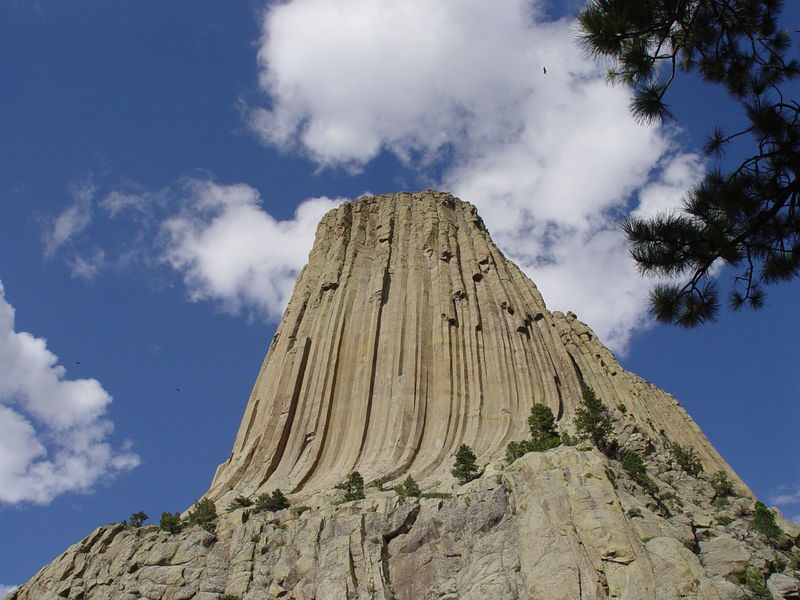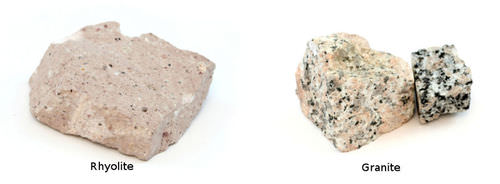4.10: Igneous Rock Classification
- Page ID
- 5370
Is this igneous rock intrusive or extrusive?
You can't really tell from this view. A close up view would show small crystals in a dark colored rock. This indicates rapid cooling from a basalt lava. The most interesting feature you can see are the hexagonal "posts." For them to form, cooling must not have been too rapid. This amazing feature is Devil's Tower in Wyoming.
Igneous Rock Classification
Igneous rocks are classified by composition and texture. The composition can be felsic, intermediate, mafic, or ultramafic. The composition depends on the minerals the rock includes. A felsic rock will contain felsic minerals.
The mineral compositions are listed in Table below. The table includes examples of minerals.
| Composition | Color | Density | Minerals |
|---|---|---|---|
| Felsic | Light | Low | Quartz, orthoclase feldspar |
| Intermediate | Intermediate | Intermediate | Plagioclase feldspar, biotite, amphibole |
| Mafic | Dark | High | Olivine, pyroxene |
| Ultramafic | Very dark | Very high | Olivine |
Texture indicates how the magma cooled. Magma that cools rapidly has small or no visible crystals. Magma that cools slowly has large crystals; reference Table above for the type of rock, the amount of silica it has, and examples.
Is this an intrusive or an extrusive igneous rock?
Is this an intrusive or an extrusive igneous rock?
Pictured above are two pairs of igneous rocks (Figures above and above). The first pair is two rocks that formed from a felsic magma. The rhyolite cooled rapidly, and the granite cooled slowly. The second pair is two rocks that formed from mafic magma. The basalt cooled rapidly, and the gabbro cooled slowly. The color of the rocks and sizes of the crystals are your clues. There are other rock pairs that you could find listed below (Table below).
| Type | Amount of Silica | Extrusive | Intrusive |
|---|---|---|---|
| Felsic | >69% SiO2 | Rhyolite | Granite |
| Intermediate | 52-63% | Andesite | Diorite |
| Intermediate-Felsic | 63-69% | Dacite | Granodiorite |
| Mafic | 45-52% | Basalt | Gabbro |
| Ultramafic | <45% | Komatiite | Peridotite |
Summary
- Igneous rocks are classified first by composition. Categories go from from felsic to ultramafic. Color can indicate composition.
- Texture is second when classifying igneous rocks. Texture indicates how a rock cooled.
- Igneous rocks are categorized in pairs. The two rocks in a pair have the same composition but different textures: gabbro-basalt, diorite-andesite, and granite-rhyolite.
Review
- Describe the formation of the igneous rock pair gabbro-basalt. Compare and contrast the two rock types.
- How does the composition of a rock affect its color?
- What are ultramafic rocks? What is their color?
Explore More
Use the resource below to answer the questions that follow.
- How does the rate of magma cooling affect crystal size?
- How does an igneous rock get a glassy texture?
- What is the name of the texture if extremely small crystals form? Where do rocks like this form?
- If there is lot of water in the cooling magma what is the texture? Where might this happen?
- What is a good example of a glassy rock? What feature does this rock have that is just like glass?
- What does felsic mean? What are the features of felsic minerals?
- What does mafic mean? What are the features of mafic minerals?
- What does ultramafic magma produce? Why is this rock important? What is its main crystal?
- How does a porphyry form?




